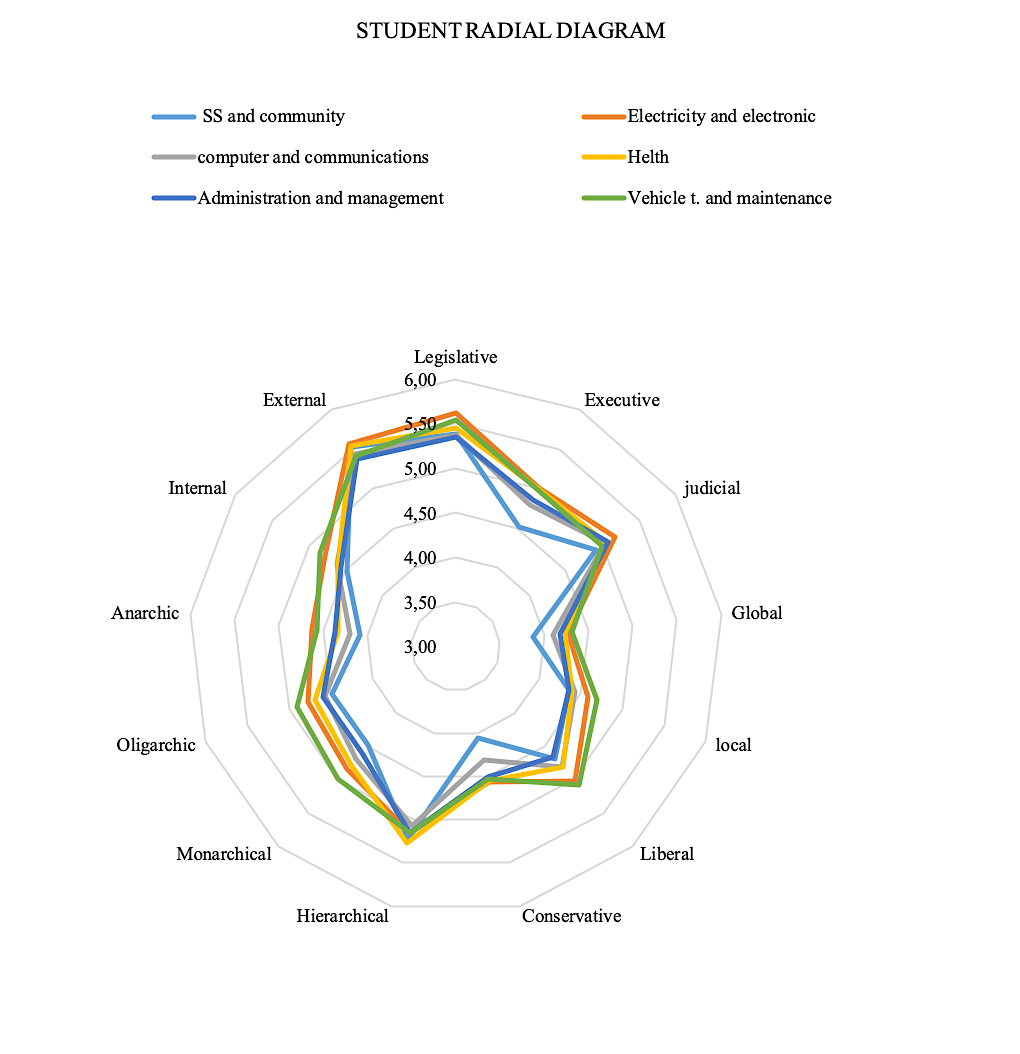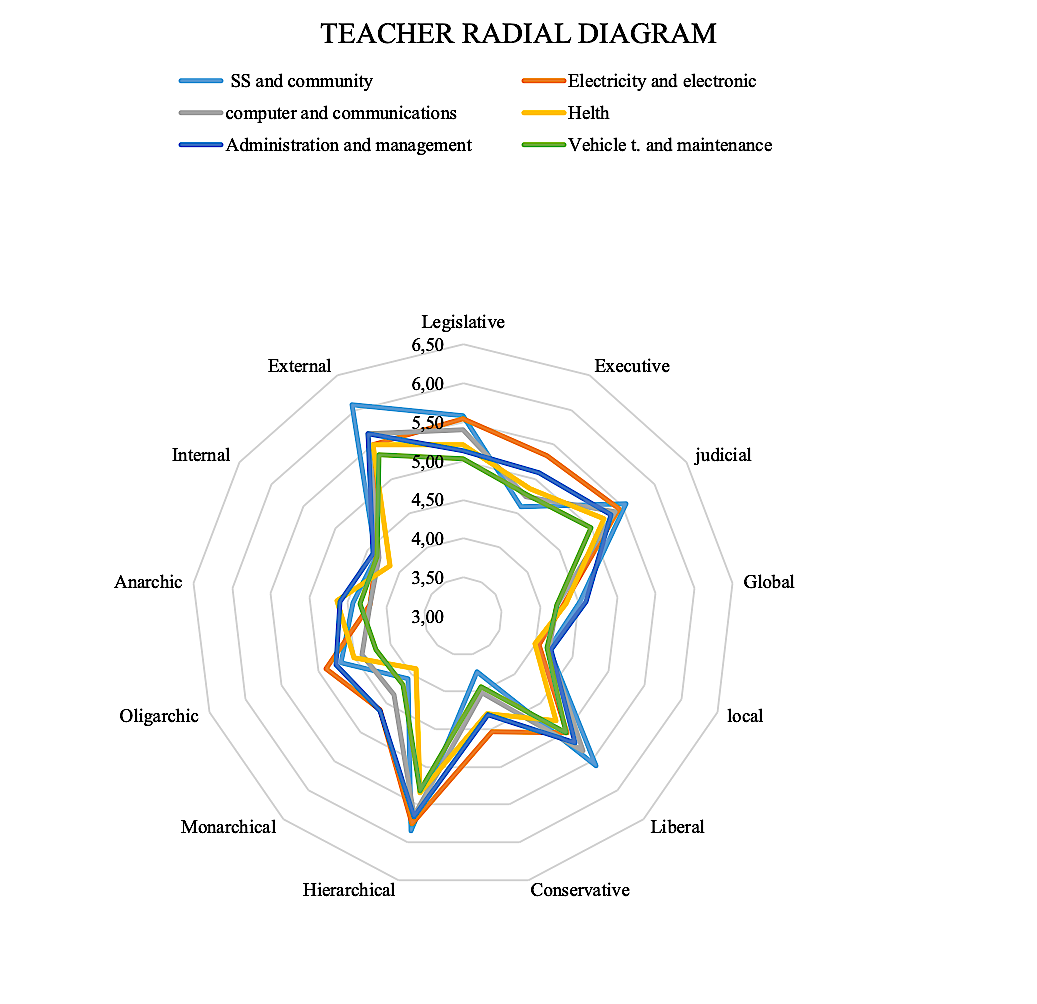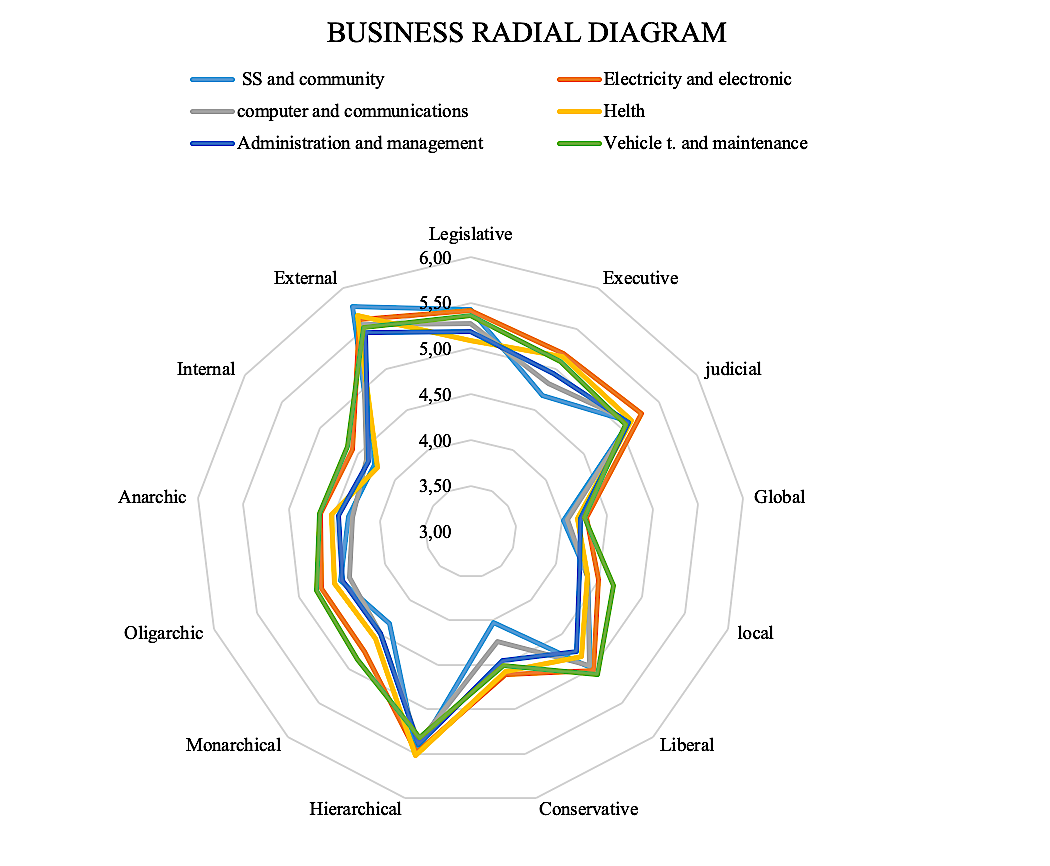Abstract
Thinking styles refer to preferences when processing information or using a skill when tackling a task. The triarchal model of intellectual styles accommodates all existing style constructions. We propose to identify the thinking styles of the students and professors of vocational training and those that the company demands in the Autonomous Community of Aragon through the Inventory of Thought Styles-Revised II (TSI-R2, 2007). For this, the professional families most demanded by students have been selected. On the other hand, the selection of educational centers is made according to the territoriality parameter, and finally, the participating companies are related to the professional families in demand. The consideration of an academic scenario is completed with the evaluation of the business context because under these premises we want to know what the company requires of its employees when they face a task. This initial approach may justify the attention that is awakened in us to know the styles of thought because the styles explain variations that cannot be attributed to other factors that manage to be important in a variety of real-world situations, both studies and work.
Keywords: Thinking stylesthinking styles inventoryvocational trainingvacational teachersvocational students
Introduction
Vocational training aims to provide students with knowledge, skills, abilities, skills and attitudes that allow them to perform a specific work activity. The theory of mental self-government proposes that people have different and particular styles of thinking, that is, preferred ways of doing things, which explains why, when thinking styles and, consequently, people's ways of acting they coincide with what is demanded of them, they are qualified as outstanding.
That is why knowing the thinking styles of students, teachers and those demanded by companies makes it possible, first, to know what style of thinking is compatible with the professional profile demanded by the company. Second, what styles are preferred by students at the end of their academic training process in each of the selected professional families and, finally, what style of thinking do teachers have that, in their teaching work, maintains a predominant style.
All this contributes to increasing the importance of the study of thinking styles in students and teaching staff of vocational training, to identify which are the prevailing thinking styles, if students and teachers know what their thinking style is and how they use them against learning proposals. And in this way contribute to avoid dropouts, reduce difficulties and increase personal satisfaction, guiding the student on the best way to manage their own style and, in short, to be able to think because “Thinking implies managing a set of cognitive skills or abilities to manage knowledge based on the aptitudes and interests of the person” ( Allueva, 2007, p. 136).
Problem Statement
Knowing the thinking styles will allow us an approach to understand the thinking of students, teachers and entrepreneurs of the Autonomous Community of Aragon.
Research Questions
Is it possible to know the thinking styles of students, teachers and entrepreneurs of professional training?
Purpose of the Study
The term of thinking style that is going to be taken into account for the study is the one used by Sternberg ( 1999) that defines style as:
Characteristic way of thinking. It does not refer to an aptitude, but to how we use the skills we have. We do not have a style, but a profile of styles. People can be practically identical in their skills and still have very different styles. (p. 38)
Styles have to do with people's favorite way of thinking ( Sternberg, 1999; Sternberg & Grigorenko, 1995). This theory proposes that each individual uses his thinking in a predominant way, and configures a style or way of solving problems, both academic and everyday.
The theory of mental self-government ( Sternberg & Grigorenko, 1995) identifies thirteen thinking styles grouped into five dimensions: 1) functions (legislative / judicial / executive style), 2) forms (monarchical / hierarchical / oligarchic / anarchic style), 3) levels (global / local style), 4) scope (internal / external style) and 5) inclinations (liberal / conservative style).
Functions:
Legislative: people often prefer to do things their own way.
Executive: people show predilection for compliance with established norms.
Judicial: people like to evaluate rules and procedures.
Shapes:
Monarchical: people are characterized by focusing on only one aspect.
Hierarchical: people enjoy having various tasks as their objective.
Oligarchic: people prefer to work on several tasks at once.
Anarchic: People have great flexibility and approach tasks randomly.
Levels
Global: people show preference for broad and general issues.
Local: people show a preference for work on concrete things.
Scope
Internal: people have a preference to work alone.
External: people have a preference for working in groups or interacting with others.
Inclination
Liberal: people tend to go beyond procedures.
Conservative: people tend to perform tasks according to existing rules.
Research Methods
The methodology through which the study was carried out is as follows:
-The sample of vocational students focuses on the students of 2nd year of both Middle and Higher Grade in centers of Zaragoza, Huesca, and Teruel of the most demanded professional families in the 2016/17 course by the students, the teaching staff that teaches the training cycles and the companies that demand these professional profiles and whose participation was promoted during the 2017/18 academic year.
-Data collection was carried out through the application of the Thinking Styles Inventory-Revised II (TSI-R2, 2007) questionnaire by Zhang and Sternberg, to students, teachers and entrepreneurs in the framework of an investigation descriptive.
Findings
a.- A sample of 873 students distributed according to the following professional families (see figure
a.1 Administration and management: 234 students
a.2 Electricity and electronic: 103 students
a.3 Computer and Communications: 108 students
a.4 Health: 172 students
a.5 SS and community services: 104 students
a.6 Vehicle Transportation and Maintenance: 152 students

b.- A sample of 164 teachers distributed according to the following professional families (see figure
b.1 Administration and management: 46 teachers
b.2 Electricity and electronic: 32 teachers
b.3 Computer and Communications: 26 teachers
b.4 Health: 20 teachers
b.5 SS and community services: 20 teachers
b.6 Vehicle transportation and maintenance: 20 teachers

c.- a sample of 254 business distributed according to the following profesional families (see figure
c.1 Administration and management: 61 business
c.2 Electricity and electronic: 31 business
c.3 Computer and Communications: 30 business
c.4 Health: 71 business
c.5 SS and community services: 31 business
c.6 Vehicle trasportation and maintenance: 30 business

Conclusion
The results obtained in the functions dimension are presented in this article since we are in obtaining the first results. The initial conclusions obtained are:
a.1-Administration and management. The predominant style of thinking in students is legislative. The teaching staff has a judicial style and the style demanded by the company is executive.
a.2-Electricity and electronic. There is a coincidence between students and teachers with a legislative thinking style, the style demanded by the company is executive.
a.3-Computer and Communications. There is a coincidence between students and teachers with a legislative style and the defendant by the company is judicial.
a.4-Helth. The students have a legislative style, in teaching staff two styles are detected with the same scores: legislative and judicial. The defendant by the company is executive.
a.5-SS and community services. There is a coincidence between the students, teachers and the defendant by the company, judicial.
a.6-Vehicle transportation and maintenance Teachers and students agree, legislative style. The defendant by the company is executive.
Acknowledgments
To all students, teachers and entrepreneurs who have participated selflessly in the realization of this study.
References
- Allueva, P. (2007). Habilidades del Pensamiento [Thinking habilities]. In M. Liesa, P. Allueva, & M. Puyuelo (Coords), Educación y acceso a la vida adulta de Personas con Discapacidad [Education and access to adult life of people with desabilities] (pp. 133-149). Barbastro, Huesca: Fundación “Ramón J. Sender”.
- Sternberg, R. J. (1999). Estilos de pensamiento. Claves para identificar nuestro modo de pensar y enriquecer nuestra capacidad de reflexión [Thinking styles. Keys to identify our way of thinking and enrich our ability to reflect]. Barcelona: Paidós.
- Sternberg, R. J., & Grigorenko, E. L. (1995). Styles of thinking in the school. European Journal for High Ability, 6(2), 201-219.
- Zhang, L. F., & Sternberg, R. J. (2005). A treefold model of intellectual styles. Educational Psychology Review, 17(1), 1-53.
Copyright information

This work is licensed under a Creative Commons Attribution-NonCommercial-NoDerivatives 4.0 International License.
About this article
Publication Date
27 May 2020
Article Doi
eBook ISBN
978-1-80296-083-9
Publisher
European Publisher
Volume
84
Print ISBN (optional)
-
Edition Number
1st Edition
Pages
1-330
Subjects
Teacher training, bullying, child abuse, abusive relationship, neglected child, neglected teenager, cognitive psychology
Cite this article as:
Elizondo, C. R. (2020). Thinking Styles In Vocational And Company Training In Aragon (Spain). In C. Salavera, P. Teruel, & J. L. Antoñanzas (Eds.), Observatory for Research and Innovation in Social Sciences, vol 84. European Proceedings of Social and Behavioural Sciences (pp. 61-67). European Publisher. https://doi.org/10.15405/epsbs.2020.05.7
